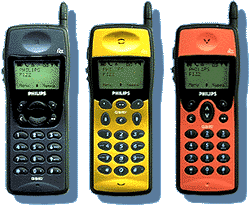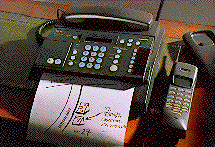Global System for Mobile Communications
 In 1992, this successful standard for Pan-European digital
cellular telephony
saw its first operational successes. The name GSM originated early in the 1980's
as the French acronym for Groupe Special Mobile, the international working group
tasked by most European PTT administrations to develop a common standard for cellular
networks. A joint standard allows international roaming across the many European
borders, until then only realized on a regional scale by the analog NMT-standard.
The main advantages of a
digital system are a larger user capacity per unit of spectrum, ease of implementation
of sophisticated encryption, authentication, and other security features, and
robustness against radio channel
imperfections. A Pan-European standard further provides economies of scale
in mass production of handheld and car terminals, which would never have been
achieved in the fragmented national markets in Europe. At January 1st, 1995, commercial
GSM service was offered in sixteen countries. The system had attracted 135
Million subscribers worldwide in 1998. It had a share of 45% of the cellular market,
and 62% of the digital cellular market. Expectations are 250 Million subscribers
in the year 2000.
In 1992, this successful standard for Pan-European digital
cellular telephony
saw its first operational successes. The name GSM originated early in the 1980's
as the French acronym for Groupe Special Mobile, the international working group
tasked by most European PTT administrations to develop a common standard for cellular
networks. A joint standard allows international roaming across the many European
borders, until then only realized on a regional scale by the analog NMT-standard.
The main advantages of a
digital system are a larger user capacity per unit of spectrum, ease of implementation
of sophisticated encryption, authentication, and other security features, and
robustness against radio channel
imperfections. A Pan-European standard further provides economies of scale
in mass production of handheld and car terminals, which would never have been
achieved in the fragmented national markets in Europe. At January 1st, 1995, commercial
GSM service was offered in sixteen countries. The system had attracted 135
Million subscribers worldwide in 1998. It had a share of 45% of the cellular market,
and 62% of the digital cellular market. Expectations are 250 Million subscribers
in the year 2000.
Technical Aspects, Features and Services

- GSM network offers pan-European roaming.
- Security
- Digital encryption
- User authentication
- Smart (SIM) card: personal number
- Can support ISDN-type services
- Call redirect, automatic callback
- Transparent G-3 fax mode
- Data Services to be standardized soon
- Due to its specific error control mechanisms, a stationary GSM channel often
is better than wireline modem, but not as fast.
Radio Access
- Frequency Division Multiple Access
Carrier spacing 200 kHz
- Time Division Multiple Access
at 8 users per carrier
- speech coding: linear predictive coding and regular pulse excitation 13 kbit/s
- channel equalization: 4 bit intervals
bit duration 3.7 microsec; maximum delay difference 16 microsec
- channel bit rate 270 kbit/s
- channel bit rate per user 22.8 kbit/s, incl. ch. coding
- Gaussian Minimum Shift Keying (GMSK)
- 1.35 bit/s/Hz
- Max cell size: 30 km (limited by guard time interval)
- Vehicle terminal: up to 8 watt
- Handheld: up to 2 watt
- Half rate speech coding possible: 16 users per carrier
- "out of band" signaling
GSM Data Services

- Voice codecs are not suitable for data
- Interworking functions needed in network
- Traffic Channel 22.8 kbit/s or 11.4 kbit/s
- Transparent service
- Constant throughput, constant delay
- no Cyclic Redundancy Check (CRC); no error detection
- Depending on Forward Error Correction (FEC) used
9.6, 4.8 or 2.4 kbit/s with full rate channel
4.8 or 2.4 with half rate channel
- Non-Transparent
- based on the transparent service, but with a Radio Link Protocol on
top of it to improve reliability.
- Automatic Repeat Request (ARQ) using error detection based on a CRC
- BER less than 10-7
�
- Short message service
- packet based
- maximum length 160 bytes
- delays up to several seconds
- uses GSM signaling channels
- longer messages split into several packets
- sequence of reception not guaranteed
- Packet data service
- based on X-25
- Now: on virtual connection per GSM traffic channel
- Services to be extended
Traffic and Transportation: floating car data
- Fax
- uses transparent data services
- fax signalling is repeated if needed
- errors of document lines can occur
�DCS 1800
- 1710 - 1785 and 1805 - 1880 MHz
- evolved from GSM
- better suited to serve densely populated areas
- 1800 MHz smaller range, smaller cells
- dual-mode terminals with GSM 900
- used by "third and fourth GSM operators"
See also:







 In 1992, this successful standard for Pan-European digital
cellular telephony
saw its first operational successes. The name GSM originated early in the 1980's
as the French acronym for Groupe Special Mobile, the international working group
tasked by most European PTT administrations to develop a common standard for cellular
networks. A joint standard allows international roaming across the many European
borders, until then only realized on a regional scale by the analog NMT-standard.
The main advantages of a
digital system are a larger user capacity per unit of spectrum, ease of implementation
of sophisticated encryption, authentication, and other security features, and
robustness against radio channel
imperfections. A Pan-European standard further provides economies of scale
in mass production of handheld and car terminals, which would never have been
achieved in the fragmented national markets in Europe. At January 1st, 1995, commercial
GSM service was offered in sixteen countries. The system had attracted 135
Million subscribers worldwide in 1998. It had a share of 45% of the cellular market,
and 62% of the digital cellular market. Expectations are 250 Million subscribers
in the year 2000.
In 1992, this successful standard for Pan-European digital
cellular telephony
saw its first operational successes. The name GSM originated early in the 1980's
as the French acronym for Groupe Special Mobile, the international working group
tasked by most European PTT administrations to develop a common standard for cellular
networks. A joint standard allows international roaming across the many European
borders, until then only realized on a regional scale by the analog NMT-standard.
The main advantages of a
digital system are a larger user capacity per unit of spectrum, ease of implementation
of sophisticated encryption, authentication, and other security features, and
robustness against radio channel
imperfections. A Pan-European standard further provides economies of scale
in mass production of handheld and car terminals, which would never have been
achieved in the fragmented national markets in Europe. At January 1st, 1995, commercial
GSM service was offered in sixteen countries. The system had attracted 135
Million subscribers worldwide in 1998. It had a share of 45% of the cellular market,
and 62% of the digital cellular market. Expectations are 250 Million subscribers
in the year 2000.

